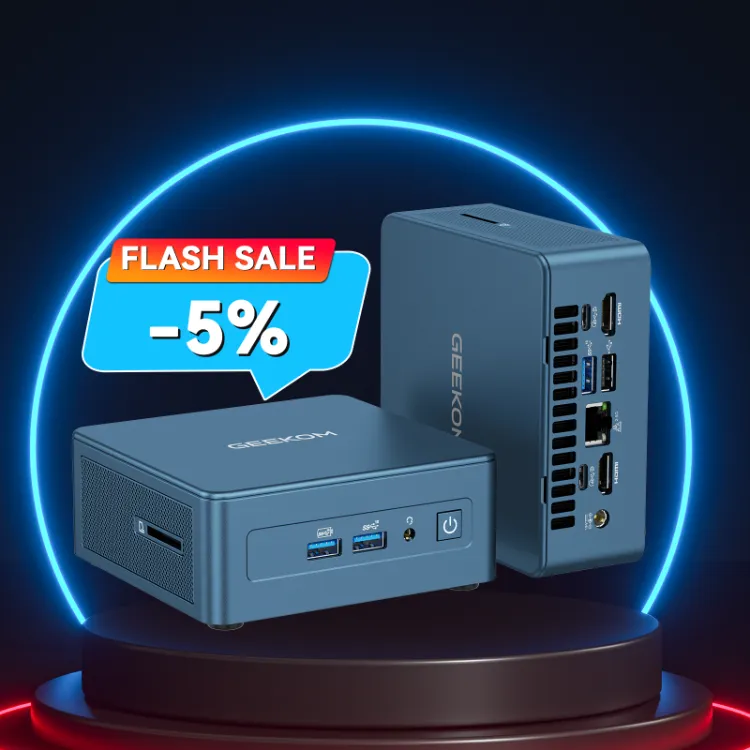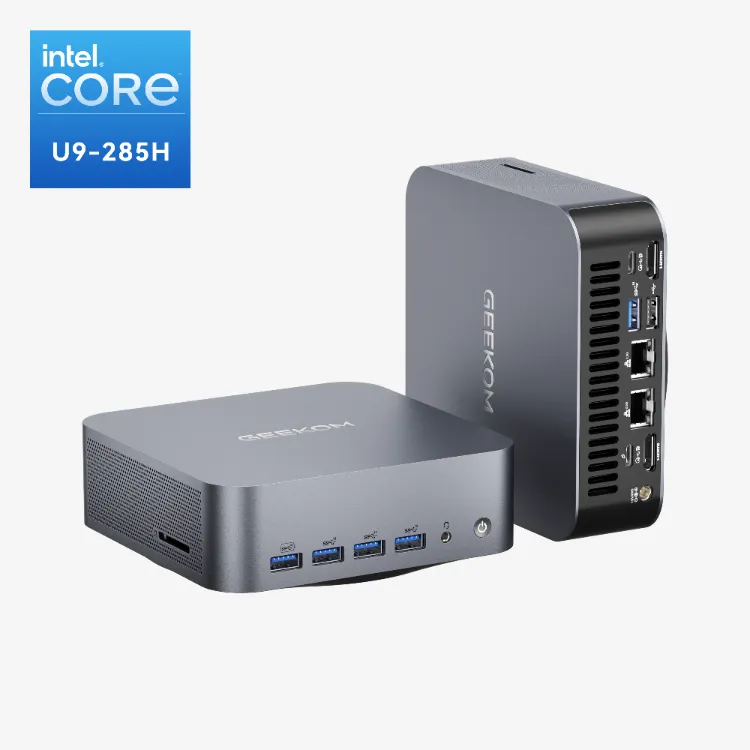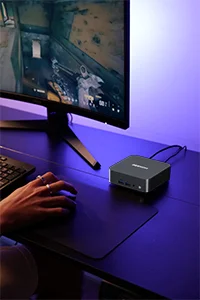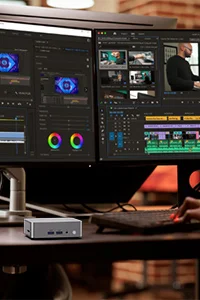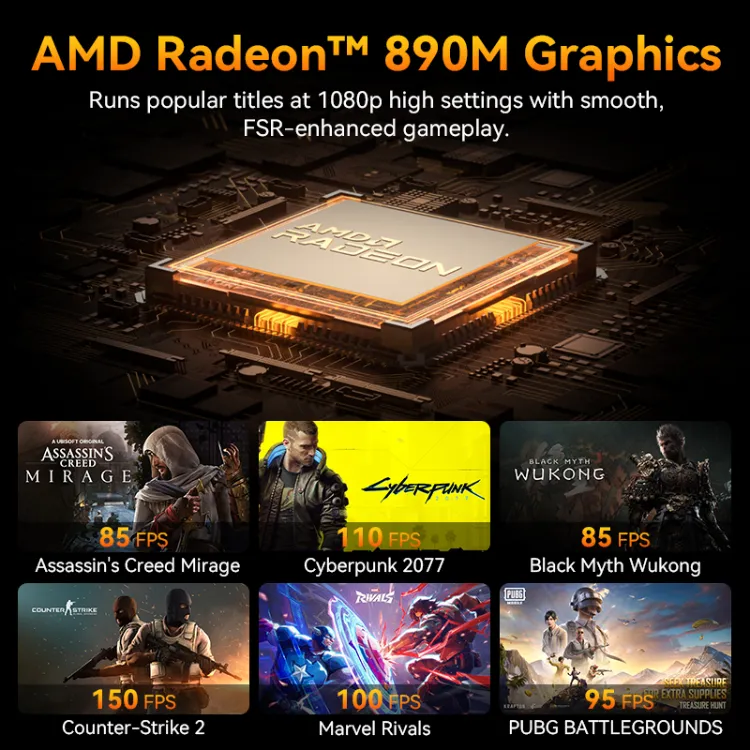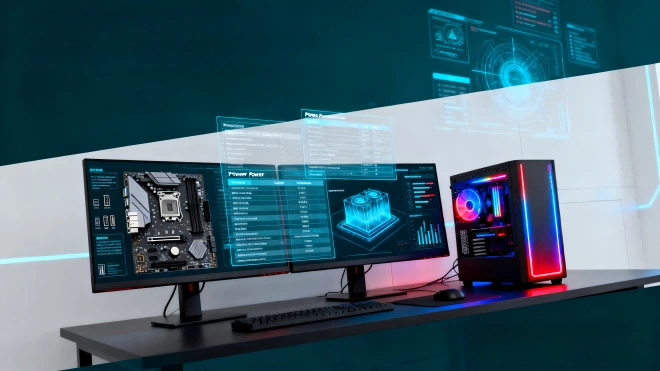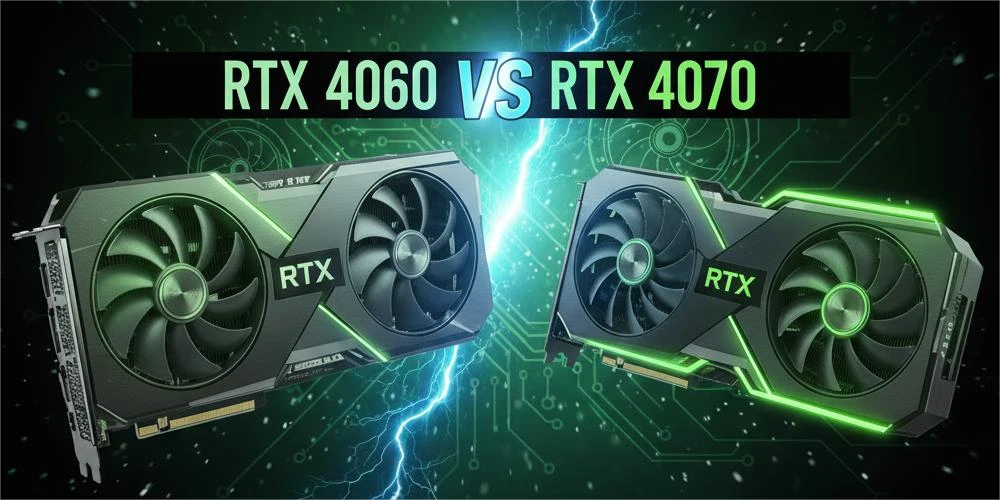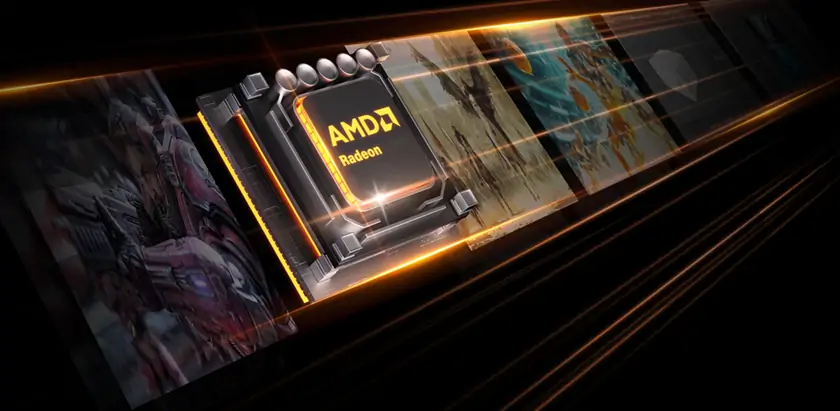What is the Radeon 890M? New Features and Improvements
Launched in June 2024, the AMD Radeon 890M is one of the latest evolution in AMD’s mobile graphics cards. It’s specifically designed to offer a balance between performance and energy efficiency, not to mention compatibility with modern mini PCs.
This model follows on from the 800M series. However, it brings major improvements that set it apart from the previous generation, particularly compared to the Radeon 780M.
Amongst these major improvements, we can cite increased GPU and memory frequencies, as well as better power consumption management. This model also offers optimised performance, particularly for graphics applications and (light to moderate) gaming.
It’s paired with Ryzen AI 9 HX mobile processors (“Strix Point” platform) built on 4nm. It features 16 compute units RDNA 3.5 (1,024 unified shaders), with a frequency that can reach up to 2,900 MHz.
As was the case with the 700M series, the Radeon 890M can support up to four SUHD 4320p60 monitors. This graphics card is particularly aimed at users of mini PCs and compact laptops. More precisely, those who want to benefit from a smooth experience for multitasking, high-resolution video streaming and recent games, all with medium settings.
In summary, the Radeon 890M is a powerful AMD integrated GPU with more recent graphics technologies. It offers superior performance in benchmarks whilst maintaining controlled thermal dissipation.
Technical Specifications
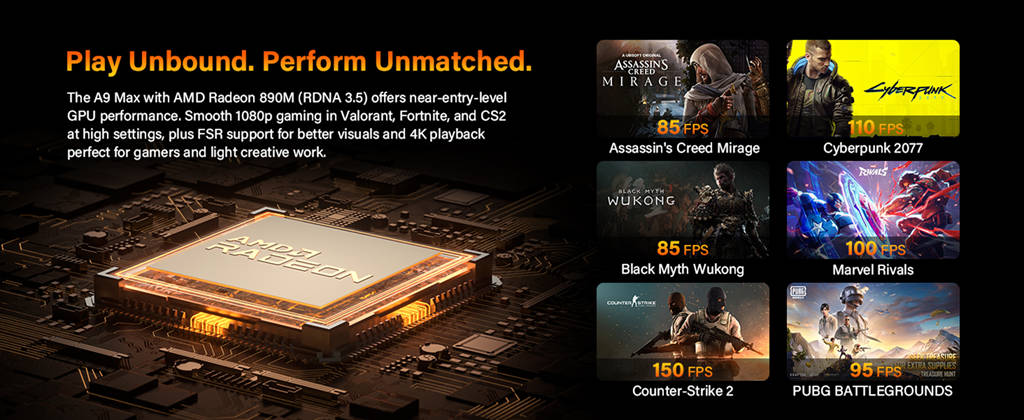
The Radeon 890M is a high-end integrated GPU from AMD. It’s intended for recent mobile processors and optimised for mini PCs and compact laptops. This model is based on RDNA 3.5 (or RDNA 3+) architecture and benefits from the latest improvements in performance and energy efficiency.
The 4nm process node, in particular, allows high frequencies to be combined with controlled consumption. This enables it to offer a good compromise between power and battery life on portable devices.
As we’ve mentioned, the AMD Radeon 890M graphics card features 16 compute units (CUs), which equates to 1,024 shaders. It’s therefore capable of reaching a maximum frequency of 2,900 MHz.
Depending on processor configurations, the integrated memory differs. However, it generally supports LPDDR5 or LPDDR5X at frequencies up to 6,400 MHz, with bandwidth sufficient for modern games and demanding graphics applications.
The AMD Radeon 890M also incorporates a next-generation ray-tracing engine. This enables realistic visual effects in compatible titles, as well as optimisations for recent video codecs, including AV1 and H.265. This provides smooth decoding of 4K and 8K content.
In terms of consumption, the Radeon 890M is designed to remain efficient, thanks in particular to a TDP (Thermal Design Power) of between 15 and 25W. As AMD stated, RDNA 3.5 is 32% faster, which enables such performance.
Thanks to this energy efficiency, temperatures remain controlled in compact chassis whilst maintaining stable performance. This card supports DirectX 12 Ultimate and Vulkan 1.3, as well as AMD proprietary technologies such as FidelityFX Super Resolution (FSR) 2.0. All of this enables an optimised graphics experience that can be adapted.
In summary, the Radeon 890M combines solid graphics performance, remarkable energy efficiency and modern technologies, enabling it to meet the needs of mini PC and high-end laptop users.
Performance Analysis
Radeon 890M: Visual Performance and Key Figures
The Radeon 890M establishes itself as the reference amongst AMD iGPUs. Thanks to impressive scores in Geekbench 6 and clear gains over the Radeon 780M, it now rivals dedicated graphics cards such as the GeForce GTX 1070.
📊 Geekbench 6 Score – Vulkan Test
➡️ +23% performance gain compared to the previous generation
📈 Evolution Compared to the Radeon 780M
Real Games
general average
Synthetic Benchmarks
in certain tests
🎮 Gaming Performance
In several titles, the Radeon 890M surpasses the desktop GeForce GTX 1650 — a rare feat for an iGPU. Here are some observed differences:
💡 Conclusion: The Radeon 890M offers performance close to a GTX 1070, whilst remaining economical and integrated — a major advancement for AMD mini PCs in 2025.
Beyond gaming, the Radeon 890M also shows real advantages in multitasking and video editing. Hardware decoding for modern codecs such as AV1, H.265 and VP9 enables smooth rendering of 4K videos. As for light 3D applications, they benefit from significant acceleration.
Whilst these performances are good, some nuances should be noted. Particularly the fact that when the TDP limit increases, the gains reduce. For example, under 28-35W conditions, the advantage over the Radeon 780M is only 9-10%. This means that to take advantage of the architecture, it’s preferable to have a platform with optimised cooling and power supply.
Conversely, with more modest configurations, around 15-20W, the Radeon 890M shows better efficiency.
In short, the Radeon 890M represents a real step up for iGPUs. It offers performance that, until recently, was still the preserve of dedicated graphics cards, whilst remaining integrated into an APU, that is to say, a processor with integrated GPU.
Concretely, this means that users of mini PCs or compact laptops can now consider recent games in Full HD, and even in 1440p depending on optimisation, without needing a dedicated GPU.
Obviously, the performance level depends on the host platform (GPU frequency, memory, cooling). However, this progression opens up new perspectives in terms of compact and high-performance device design.
Competitive Comparison
The AMD Radeon 890M is amongst the high-end integrated GPUs. However, it remains instructive to compare it with other integrated graphics solutions or entry-level dedicated ones. This provides a better understanding of the differences and improvements of this model.
Regarding AMD, the Radeon 890M directly succeeds the 700 series. Based on synthetic benchmarks and real games, we can see significant gains of 20 to 35% in performance, which is not insignificant.
Concretely, this improvement translates into a better ability to run recent titles in 1080p, particularly with medium graphics settings, whilst maintaining low energy consumption thanks to controlled TDP.
AMD faces direct competition from NVIDIA. The Radeon 890M therefore finds itself competing with integrated GPUs such as the GeForce RTX 405 Laptop GPU or certain MX models from the previous generation. However, its better performance/consumption ratio in mini PCs and compact laptops enables it to make the difference.
Let’s take an example. A GeForce RTX 405 sometimes offers slightly superior raw performance, but it often requires more powerful cooling and a higher TDP — elements that aren’t ideal for very compact devices.
Now let’s compare with Intel. The AMD Radeon 890M far exceeds Iris Xe integrated graphics solutions in most games and 3D applications. It’s true that Intel iGPUs are efficient for office work and multimedia, but their power remains limited for 1080p gaming or more demanding 3D workloads.
In terms of technologies, the Radeon 890M benefits from RDNA 3.5, hardware ray-tracing, and compatibility with FSR 2.0. This gives it a clear advantage for upscaling and performance optimisation. These various points strengthen its position against its entry/mid-range competitors.
The Radeon 890M stands out through its balance between performance, energy efficiency and compatibility with compact devices. It offers a good alternative to Intel integrated GPUs and NVIDIA solutions in the same category, whilst clearly surpassing AMD’s previous generation.
Mini PC Equipped with the Radeon 890M: GEEKOM A9 Max
The GEEKOM A9 Max is a compact mini PC that integrates the Radeon 890M integrated GPU via the AMD Ryzen AI 9 HX 370 APU. It offers a solid graphics solution in a reduced format. It features 12 cores/24 threads and the 4nm process. These elements enable it to reach high frequencies and fully exploit the Radeon 890M.
Let’s look at its specifications. This mini PC offers, amongst other things:
- AI: CPU/NPU/GPU triple-engine synergy, up to 80 TOPS computing power, high efficiency, low power consumption, and ultra-fast responsiveness
- High-Speed Storage: Dual-channel DDR5 memory (up to 128GB) and dual M.2 slots (2280+2230) supporting up to 8 TB of PCIe 4.0 SSD storage expansion
- Dual USB4 Ports (Rival OCuLink): Unlock next-generation connectivity. Dual USB4 ports offer Thunderbolt-speed data transfer (40Gbps), dual 8K display output, and support for external graphics cards, effectively replacing OCuLink ports.
This makes the GEEKOM A9 Max a versatile mini PC for gaming, content creation or multi-screen use.
For graphics performance, the AMD Radeon 890M in the chassis enables comfortable 1080p gaming at high settings. For this model, GEEKOM announces ~110 FPS (Cyberpunk 2077) or ~150 FPS (for Counter-Strike 2).
Additionally, this model features an “IceBlast 2.0” cooling system with copper heat pipes and optimised ventilation. This enables it to maintain stable performance without excessive throttling, even in a mini PC format.
GEEKOM A9 Max — Showcase for the Radeon 890M
The GEEKOM A9 Max is an excellent showcase for the Radeon 890M. It combines graphics power, compactness and modern connectivity. An ideal choice for those who want a high-performance mini PC without a dedicated graphics card.
✅ Strengths
- • High-performance integrated GPU for 1080p and light ray-tracing
- • Compact format ideal for desk or small space
- • Complete and modern connectivity
- • Expandable storage and RAM
- • Silent IceBlast 2.0 cooling
⚠️ Weaknesses
- • Limited performance in 1440p/4K on very demanding games
- • Relatively high price (£850 – £1,200)
- • Limited GPU upgradeability
- • Use oriented towards compact rather than an upgradeable gaming desktop
💡 Recommended use: Gamers and creators seeking power without a dedicated GPU.
💰 Price range: Between £850 and £1,200.
❄️ Cooling: IceBlast 2.0 for optimised airflow.
Future Perspectives
With the Radeon 890M, based on RDNA 3.5 architecture, AMD takes a new step in the integrated GPU sector. With its 16 compute units and 4nm process, it significantly improves performance, particularly compared to the previous generation.
However, other developments can be envisaged for the future:
- A rise in iGPU power in ultra-compact computers and mini PCs, for light gaming, streaming or content creation.
- Broader integration of upscaling and AI technologies such as FidelityFX Super Resolution (FSR) 2.0 and possibly 3.0. This will enable integrated graphics processors to remain efficient even at higher resolutions.
At the same time, AMD is already preparing next generations, such as RDNA 4 architecture and the possible move to RDNA 5. Changes that should enable major architectural improvements, particularly for multi-die or “chiplet” GPU architectures.
The Radeon 890M doesn’t represent an end, but rather a starting point. It paves the way for increasingly high-performance mobile and compact platforms and shows that the gap between integrated GPU and dedicated GPU will continue to narrow.
Conclusion
The Radeon 890M establishes itself as one of AMD’s most high-performing IGPUs. It offers a perfect balance between energy efficiency, power and compatibility with compact laptops and mini PCs.
Compared to the previous generation, the AMD Radeon 890M ensures significant gains in gaming and graphics applications. It also integrates modern technologies such as ray-tracing and FSR 2.0 upscaling.
It particularly shows its full potential on devices like the GEEKOM A9 Max, enabling gaming and work without needing a dedicated GPU. In summary, the Radeon 890M paves the way for new perspectives for compact and versatile devices, which only confirms the rise in power of modern iGPUs.



